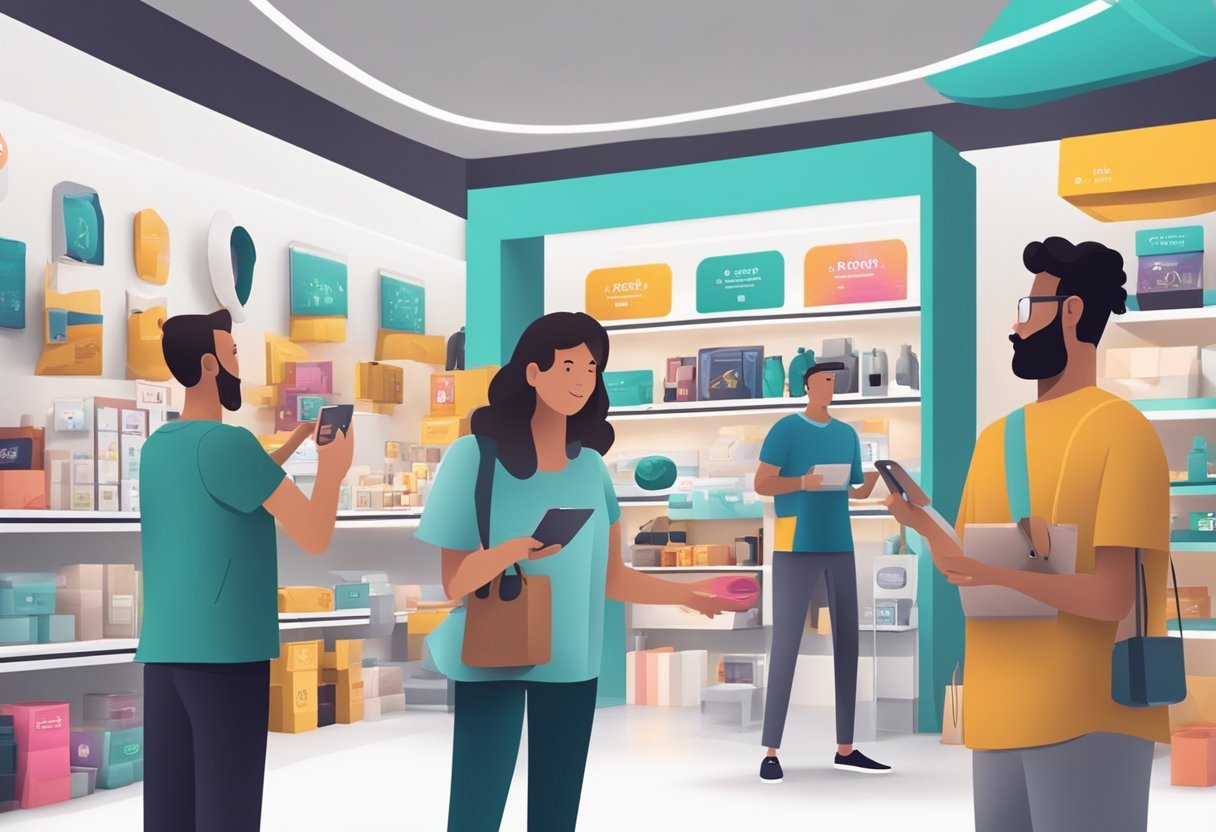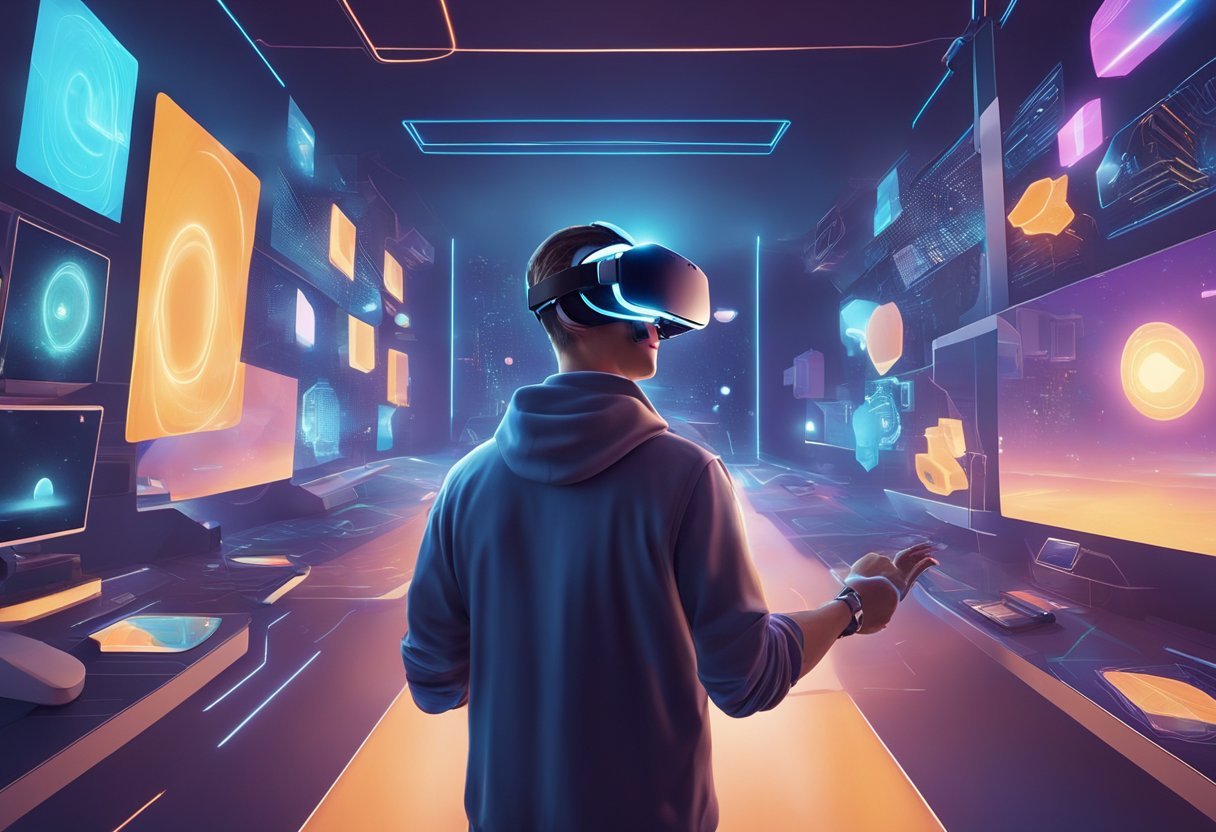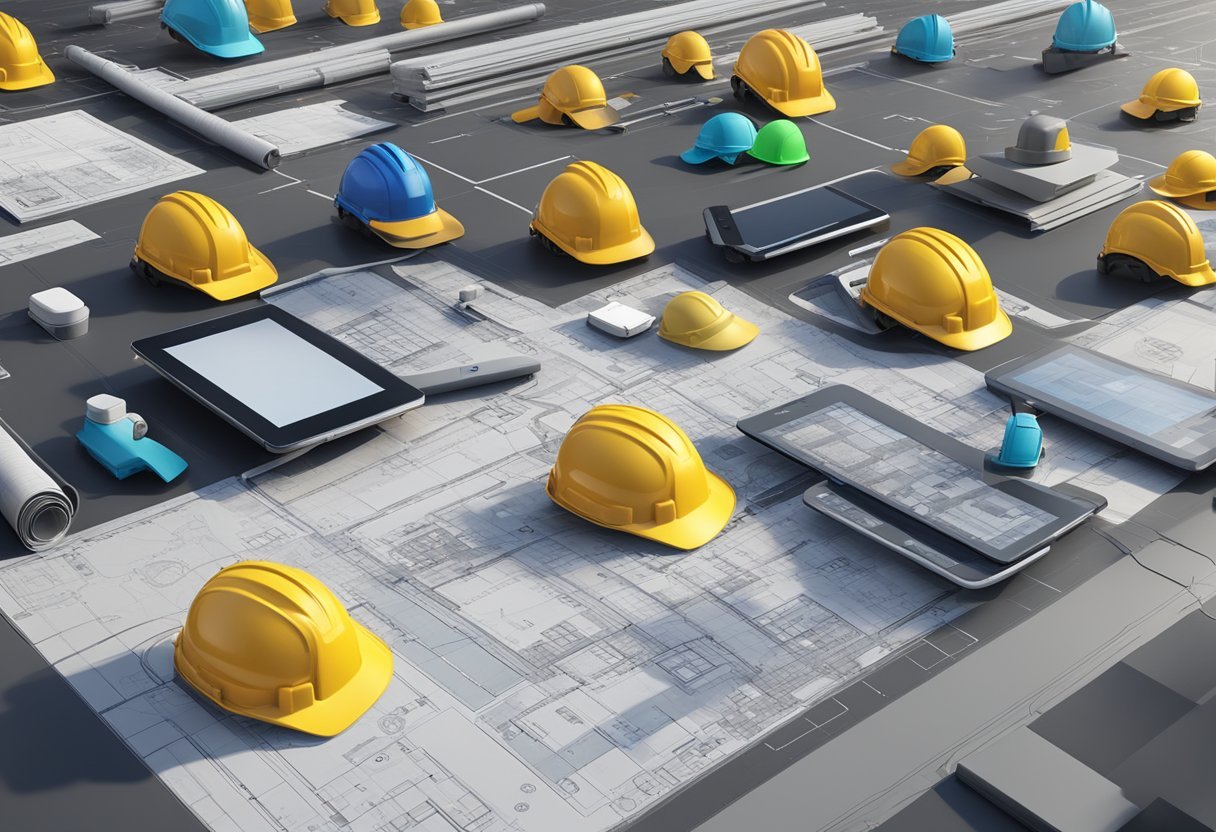Augmented reality (AR) technology has revolutionized the way people shop, transforming the traditional brick-and-mortar stores into immersive shopping experiences. AR technology allows customers to visualize products in a virtual environment, providing them with a realistic view of how the product will look in real life. This technology has the potential to enhance customer experience and increase sales for retailers. In this blog post, we will explore the concept of an augmented reality store and share with you the best 11 augmented reality stores for the best experience.
AR technology has already been implemented in various industries, including fashion and beauty. For instance, beauty brands are using AR technology to allow customers to virtually try on makeup products before making a purchase. Similarly, fashion brands are using AR to allow customers to visualize how a particular outfit will look on them, without having to physically try it on. This technology has the potential to revolutionize the way people shop, making it easier and more convenient for customers to make informed decisions.
As AR technology continues to evolve, it is expected to become more accessible and cost-effective, making it easier for retailers to implement it in their stores. In the future, AR technology is expected to become an integral part of the retail industry, providing customers with a personalized and immersive shopping experience.
Key Takeaways
- AR technology has transformed the way people shop, providing customers with a realistic view of how products will look in real life.
- AR technology has been implemented in various industries, including fashion and beauty, to enhance customer experience and increase sales.
- As AR technology continues to evolve, it is expected to become more accessible and cost-effective, making it an integral part of the retail industry in the future.
The Evolution of Retail with AR
Augmented Reality (AR) is transforming the retail industry by blending digital enhancements with the physical world. AR technology overlays digital information onto the physical world, bridging the gap between online and in-store shopping. In this section, we will explore the impact of AR on retail and the innovative brands leading the way.
From Physical to Digital: The Impact of AR on Retail
The retail industry has evolved significantly over the years, from physical stores to e-commerce and now to AR-powered shopping experiences. With the rise of AR, customers can now interact with products in ways that were previously not possible. AR allows customers to visualize products in their real environment, try on clothes and accessories virtually, and even see how furniture would look in their homes before making a purchase.
AR has also made shopping more convenient and personalized. Customers can now use their smartphones to access AR-powered experiences, eliminating the need for physical stores. This has opened up new opportunities for retailers to reach customers in different locations and at different times.
Innovative Brands Leading the Way
Several innovative brands are leading the way in the adoption of AR in the retail sector. For example, Warby Parker’s customers can use AR to try on glasses from the comfort of their homes, so they can pick out the perfect frames. L’Oreal now offers augmented reality-powered makeup try-on, allowing customers to test out different makeup looks without having to physically apply the products.
Another example is IKEA, which has developed an AR-powered app that allows customers to see how furniture would look in their homes before making a purchase. This has significantly reduced the number of returns and increased customer satisfaction.
AR is transforming the retail industry by enhancing how customers interact with products. The rise of AR-powered shopping experiences has made shopping more convenient, personalized, and engaging. Innovative brands are leading the way in the adoption of AR, and we can expect to see more retailers follow suit in the coming years.
Top 11 Augmented reality stores
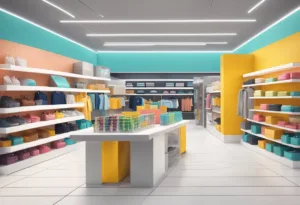
- Nike
- Seinfeld Set Replica
- Instant Pot
- Bethesda
- Nomatic
- Treat a Dog
- Furniture AR
- Beauty AR
- DIY AR
- Jewelry AR
- Fashion Retail AR
Nike
Nike, a globally recognized brand in athletic footwear and apparel, has integrated augmented reality into their stores to enhance the customer experience. As an augmented reality store, Nike utilizes this innovative technology to allow customers to scan items such as shoes or clothing, providing an immersive view of the product’s features and benefits. This AR experience can include seeing how the shoes would look on their feet or how clothing fits without physically trying them on, thereby streamlining the shopping process and engaging customers in a unique way.
The use of AR in Nike stores exemplifies how the brand is leveraging the latest technologies to merge the physical and digital worlds, offering a cutting-edge shopping experience that aligns with their reputation for innovation in the sports industry.
Seinfeld Set Replica
The Seinfeld Set Replica store offers fans of the iconic television show “Seinfeld” the opportunity to purchase detailed replicas of the set. This augmented reality store enhances the buying experience by using AR to allow customers to visualize the set replicas in their own space before making a purchase.
By providing an immersive view of how the replica would look in a customer’s home, the store not only ensures customer satisfaction but also creates an engaging and memorable shopping experience. The AR feature bridges the gap between online shopping and physical reality, giving customers a unique way to connect with their favorite show and make informed decisions about their purchases.
Instant Pot
The Instant Pot store sells the popular multicooker known for its versatility in cooking a variety of dishes. As an augmented reality store, it provides customers with an AR experience that allows them to see the Instant Pot in their kitchen, understand its scale, and explore its features in a virtual format.
This interactive approach helps customers to better understand how the Instant Pot will fit into their cooking routine and space, making the online shopping experience more tangible and reassuring. The store’s use of AR technology demonstrates a commitment to customer satisfaction and innovation in the home appliance industry.
Bethesda
Bethesda, a renowned video game publisher, has an augmented reality store that sells merchandise related to their famous gaming franchises. The AR experience offers gamers the chance to preview items such as collectibles and apparel in a virtual space, giving them a sense of the product’s look and feel before purchasing.
This immersive experience is designed to engage the gaming community by bringing the virtual worlds of their favorite games into the real world, enhancing the overall customer experience and fostering a deeper connection with the brand.
Nomatic
Nomatic is an augmented reality store that specializes in selling travel bags and gear designed for life on the move. The store’s AR feature enables customers to virtually try out products, such as backpacks, by visualizing them in their intended environment, whether it’s for daily commute or international travel.
This interactive shopping experience allows customers to explore the functionality and design of Nomatic products in detail, ensuring that they select the perfect travel companion for their needs. The use of AR technology in the store reflects Nomatic’s commitment to innovation and customer-centric design in the travel gear market.
Treat a Dog
Treat a Dog is an augmented reality store that caters to pet owners looking for high-quality dog beds and accessories. The store’s AR experience allows customers to visualize the dog beds in their own home, helping them to choose the right size, color, and style for their pet and living space.
This personalized shopping experience not only enhances customer satisfaction but also demonstrates the store’s dedication to providing pet owners with the best products for their furry friends. The AR feature adds an extra layer of convenience and confidence to the online shopping process for pet-related goods.
Furniture AR
Furniture AR stores offer customers the ability to preview furniture pieces in their own homes before making a purchase. By using augmented reality, these stores provide an interactive experience that allows customers to visualize different furniture options in terms of size, style, and placement.
This immersive approach helps to eliminate the guesswork involved in furniture shopping, ensuring that the pieces selected will fit perfectly within the customer’s space and decor. Furniture AR stores are revolutionizing the way people shop for home furnishings by combining convenience with a personalized shopping experience.
Beauty AR
Beauty AR stores are transforming the cosmetics industry by providing a virtual try-on experience for makeup and skincare products. Customers can use augmented reality to see how different shades and formulas look on their skin without physically applying the products.
This innovative approach not only enhances the shopping experience but also promotes a more hygienic way to test beauty products. Beauty AR stores are leading the way in digital innovation, offering customers a fun, interactive, and convenient way to discover and purchase beauty products that are perfect for their needs.
DIY AR
DIY AR stores cater to the home improvement and crafting community by offering an augmented reality experience that assists with project planning and product selection. Customers can use AR to visualize how materials and tools will look and function in their actual project space, providing a practical and immersive way to plan their DIY endeavors.
This tailored approach helps to ensure that customers purchase the right products for their projects, reducing the likelihood of returns and increasing satisfaction. DIY AR stores are enhancing the home improvement shopping experience by providing valuable insights and a touch of innovation to the creative process.
Jewelry AR
Jewelry AR stores offer a unique and personalized shopping experience by allowing customers to try on jewelry virtually. With augmented reality, customers can see how different pieces, such as rings, necklaces, and earrings, look on them without visiting a physical store.
This interactive experience not only provides convenience but also adds a layer of confidence to the purchasing decision, as customers can see how the jewelry complements their style and appearance. Jewelry AR stores are setting a new standard in the fine jewelry market by merging the luxury of high-end jewelry with the cutting-edge technology of augmented reality.
Fashion Retail AR
Fashion Retail AR stores are revolutionizing the way customers shop for clothing and accessories. By integrating augmented reality into the shopping experience, these stores allow customers to see how garments look on their body type, experiment with different styles, and mix and match outfits virtually.
This level of interaction provides a personalized and engaging shopping experience that goes beyond traditional online browsing. Fashion Retail AR stores are at the forefront of digital innovation in the fashion industry, offering a seamless blend of style and technology to cater to the modern shopper’s needs.
AR Technology in Shopping

Augmented reality (AR) technology is revolutionizing the way people shop. AR technology allows customers to virtually try on and test products through an electronic device such as a smartphone or virtual reality headset. This technology has been gaining popularity in recent years, with retailers like IKEA, Apple, and Shopify investing in AR platforms and tools to enhance the customer experience.
Understanding AR Technology
AR technology uses 3D models and computer-generated images to create a virtual environment that overlays the real world. AR platforms like Arki and ARKit use advanced technologies like Lidar and machine learning to create accurate and realistic virtual representations of products.
AR Platforms and Tools
Retailers are investing in AR platforms and tools to enhance the customer experience. AR platforms like Lens Studio and AR Quick Look allow customers to visualize products in their homes before making a purchase. These platforms use AR technology to create a virtual environment that overlays the real world, allowing customers to see how products will look in their homes.
Trying on products in augmented reality
One of the most significant benefits of AR technology in shopping is the ability to try on products virtually. Customers can use AR technology to see how products will look on them before making a purchase. This feature is particularly useful for products like clothing and makeup, where customers want to see how the product will look on them before buying.
Visualizing products at home with AR
AR technology also allows customers to visualize products in their homes before making a purchase. Platforms like AR Quick Look and Lens Studio use AR technology to create a virtual environment that overlays the real world, allowing customers to see how products will look in their homes. This feature is particularly useful for furniture and home decor products.
Products in augmented reality
Retailers are using AR technology to create virtual stores where customers can browse and purchase products in augmented reality. These virtual stores use AR technology to create a virtual environment that overlays the real world, allowing customers to browse and purchase products in a virtual environment.
AR technology is revolutionizing the way people shop, and retailers are investing in AR platforms and tools to enhance the customer experience. With the ability to try on products virtually and visualize products in their homes, customers can make more informed purchasing decisions.
Enhancing Customer Experience in AR Stores

Augmented Reality (AR) is transforming the retail industry by providing customers with an immersive and interactive shopping experience. AR technology overlays digital content onto the real world, enhancing the shopping process and providing unique benefits to both customers and retailers.
Personalization and Customization through AR
One of the major benefits of AR in retail is the ability to offer personalized and customized shopping experiences. AR technology can provide customers with personalized recommendations based on their preferences and purchase history. For example, a customer can use AR to see how a piece of furniture would look in their home before making a purchase. This personalized and immersive shopping experience can help to increase customer loyalty and drive sales.
Improving Conversion Rates with Virtual Try-Ons
AR technology can also help to improve conversion rates by offering virtual try-ons. Virtual fitting rooms allow customers to see how clothes or accessories would look on them without physically trying them on. This not only saves time but also provides a more hygienic and convenient shopping experience. By providing customers with the ability to try on products virtually, retailers can increase the likelihood of a sale and reduce the number of returns.
AR technology is transforming the retail industry by providing customers with an immersive and interactive shopping experience. By offering personalized and customized shopping experiences and virtual try-ons, retailers can improve customer loyalty and drive sales.
AR in Fashion and Beauty Industries
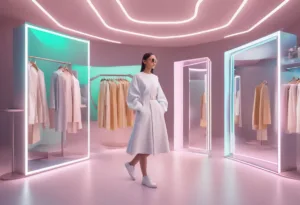
Augmented Reality (AR) has revolutionized the fashion and beauty industries by providing immersive shopping experiences to customers. AR technology enables customers to try on clothing and makeup virtually, which has become increasingly popular in recent years. This section will discuss how AR is being used in the fashion and beauty industries to build brand loyalty and provide immersive experiences to customers.
Virtual Fitting Rooms and Makeup Trials
Virtual fitting rooms and makeup trials are among the most popular applications of AR in the fashion and beauty industries. Nike, L’Oreal, FaceCake, Warby Parker, and PacSun are among the brands that have integrated AR technology into their online stores to provide customers with virtual try-on experiences. Customers can try on clothing and makeup virtually, which helps them make better purchasing decisions. AR technology also reduces the number of returns, which is a significant problem for online retailers.
Emma Chamberlain, a popular YouTuber, collaborated with PacSun to launch an AR-powered virtual store. The virtual store provides customers with a unique shopping experience by enabling them to browse and try on clothes virtually. The virtual store also features a virtual photo booth that customers can use to take pictures of themselves wearing their favorite outfits.
Building Brand Loyalty with Immersive Experiences
AR technology has also been used to build brand loyalty by providing immersive experiences to customers. AR-powered pop-up stores have become increasingly popular in recent years. These stores provide customers with immersive experiences that are not possible in traditional stores. For example, L’Oreal launched an AR-powered pop-up store in 2019 that enabled customers to try on makeup virtually and explore the brand’s history through an interactive exhibit.
Immersive shopping experiences have become an essential tool for building brand loyalty. Customers are more likely to return to a brand that provides them with an immersive experience than a brand that does not. AR technology has made it possible for brands to provide customers with immersive experiences that are not possible in traditional stores.
AR technology has transformed the fashion and beauty industries by providing customers with immersive shopping experiences. Virtual fitting rooms and makeup trials have become increasingly popular in recent years, and brands such as Nike, L’Oreal, and PacSun have integrated AR technology into their online stores.
AR-powered pop-up stores have also become popular in recent years, providing customers with immersive experiences that are not possible in traditional stores. AR technology has become an essential tool for building brand loyalty and providing customers with unique shopping experiences.
The Future of Augmented Reality Stores
Augmented Reality (AR) is a technology that is rapidly gaining popularity in the retail industry. The technology offers a unique shopping experience that is immersive and engaging, making it a valuable asset for businesses looking to attract and retain customers.
Emerging Trends in AR Shopping
The future of AR stores is bright, with emerging trends that are set to shape the industry. One of the most significant trends is the adoption of AR by Gen Z, who are digital natives. This generation has grown up with technology and expects brands to provide a seamless shopping experience that includes AR.
Another trend is the use of AR in virtual stores, which allows customers to shop from the comfort of their homes. This trend has gained significant traction during the pandemic, where visibility and accessibility are crucial.
The Role of AR in Post-Pandemic Retail
The pandemic has accelerated the adoption of AR in retail, with businesses looking to provide a safe and contactless shopping experience. AR technology allows customers to try on clothes virtually, which reduces the need for physical contact.
Business leaders are also embracing AR as a way to enhance their brand’s visibility and provide a unique shopping experience. The technology allows businesses to differentiate themselves from their competitors, which is essential in a crowded market.
In China, AR is already a mainstream technology in retail, with businesses using it to provide an immersive and engaging shopping experience. This trend is set to continue, with businesses in other parts of the world looking to adopt AR to stay competitive.
The future of AR stores is bright, with businesses looking to adopt the technology to provide a unique and engaging shopping experience. The pandemic has accelerated the adoption of AR, making it a valuable asset for businesses looking to provide a safe and contactless shopping experience. As the technology becomes more accessible, businesses will need to develop the skills and knowledge to leverage it effectively.
Frequently Asked Questions
How does augmented reality enhance the shopping experience for consumers?
Augmented reality enhances the shopping experience for consumers by allowing them to visualize and interact with products in a more immersive way. With AR, customers can see how a product would look in their home or on their body before making a purchase. This technology also allows for a more personalized shopping experience, as customers can customize their products with different colors, designs, and features. By enhancing the shopping experience, AR technology can increase customer satisfaction and loyalty.
Can you list some popular retailers that have successfully integrated AR into their stores?
Several popular retailers have successfully integrated AR into their stores, including IKEA, Sephora, and Wayfair. IKEA’s AR app allows customers to see how furniture would look in their homes before making a purchase. Sephora’s Virtual Artist app allows customers to try on makeup virtually. Wayfair’s AR app allows customers to see how furniture and decor would look in their homes before making a purchase.
What are the key differences between shopping with AR and shopping with VR technologies?
The key difference between shopping with AR and shopping with VR technologies is that AR enhances the real world by adding digital content, while VR creates a completely immersive digital environment. With AR, customers can see and interact with real-world objects enhanced by digital content, while with VR, customers are completely immersed in a digital environment. AR is typically used in retail environments to enhance the shopping experience, while VR is often used in gaming and entertainment.
What are the benefits for companies implementing AR in their retail strategies?
The benefits for companies implementing AR in their retail strategies include increased customer engagement, improved customer satisfaction, and increased sales. By allowing customers to visualize and interact with products in a more immersive way, AR technology can increase customer engagement and satisfaction. AR technology can speed up time-to-purchasing decisions, which leads to more sales and better ROI on sales and marketing.
Where can I find open-source AR shopping app projects for development reference?
There are several open-source AR shopping app projects available for development reference, including ARKit by Apple, ARCore by Google, and Vuforia by PTC. These platforms provide developers with the tools and resources needed to create AR shopping apps for various platforms and devices.
How has AR technology evolved in the context of online shopping platforms?
AR technology has evolved in the context of online shopping platforms by providing customers with a more immersive and personalized shopping experience. With AR, customers can see how products would look in their home or on their body before making a purchase, which can increase customer satisfaction and loyalty. AR technology can speed up time-to-purchasing decisions, which leads to more sales and better ROI on sales and marketing. As AR technology continues to evolve, it is expected to become an increasingly important part of online shopping platforms.

